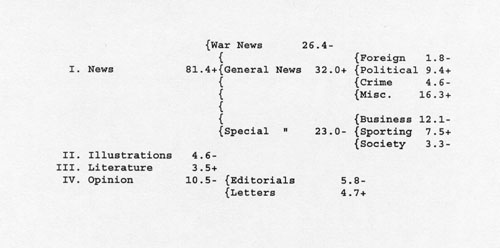CHAPTER IV
|
| 14 | percent | read but one paper |
| 46 | " | " two papers |
| 21 | " | " three papers |
| 10 | " | " four papers |
| 3 | " | " five papers |
| 2 | " | " six papers |
| 3 | " | " all the papers (eight at the time of this inquiry). |
|
The two- and three-paper readers are sixty-seven percent, which comes
fairly close to the seventy-one percent in Scott's group who rate
themselves at fifteen minutes a day. The omnivorous readers of from
four to eight papers coincide roughly with the twenty-five percent who
rated themselves at more than fifteen minutes.
It is still more difficult to guess how the time is distributed. The college students were asked to name "the five features which interest you most." Just under twenty percent voted for "general news," just under fifteen for editorials, just under twelve for "politics," a little over eight for finance, not two years after the armistice a little over six for foreign news, three and a half for local, nearly three for business, and a quarter of one percent for news about "labor." A scattering said they were most interested in sports, special articles, the theatre, advertisements, cartoons, book reviews, "accuracy," music, "ethical tone," society, brevity, art, stories, shipping, school news, "current news," print. Disregarding these, about sixty-seven and a half percent picked as the most interesting features news and opinion that dealt with public affairs. This was a mixed college group. The girls professed greater interest than the boys in general news, foreign news, local news, politics, editorials, the theatre, music, art, stories, cartoons, advertisements, and "ethical tone." The boys on the other hand were more absorbed in finance, sports, business page, "accuracy" and "brevity." These discriminations correspond a little too closely with the ideals of what is cultured and moral, manly and decisive, not to make one suspect the utter objectivity of the replies. Yet they agree fairly well with the replies of Scott's Chicago business and professional men. They were asked, not what features interested them most, but why they preferred one newspaper to another. Nearly seventy-one percent based their conscious preference on local news (17.8%), or political (15.8%) or financial (11.3%), or foreign (9.5%), or general (7.2%), or editorials (9%). The other thirty percent decided on grounds not connected with public affairs. They ranged from not quite seven who decided for ethical tone, down to one twentieth of one percent who cared most about humor. How do these preferences correspond with the space given by newspapers to various subjects? Unfortunately there are no data collected on this point for the newspapers read by the Chicago and New York groups at the time the questionnaires were made. But there is an interesting analysis made over twenty years ago by Wilcox. He studied one hundred and ten newspapers in fourteen large cities, and classified the subject matter of over nine thousand columns. Averaged for the whole country the various newspaper matter was found to fill: |
